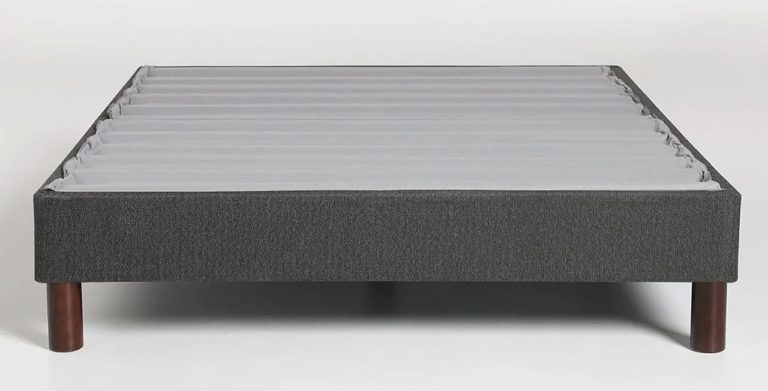When you buy through our links, we may earn a commission. Products or services may be offered by an affiliated entity. Learn more.
The Best Bed Frames of 2025
It might be tempting to select your bed frame based on its appearance alone, but other factors can be even more impactful. The right frame can reduce the likelihood of your bed developing lasting sagging as a result of inadequate support, and its height can affect how easy it is to get into or out of bed. Similarly, a well-built frame can remain silent when you move on the bed, while a lower-quality option may creak or feel less stable.
We’ll highlight some of the best bed frames on the market and explain what makes them unique. We’ll also share some of the most critical factors to consider as you shop for a new bed frame.
Our Top Picks
-
Best Overall – Saatva Santorini
View Details
-
Best Value – DreamCloud Bed Frame with Headboard
View Details
-
Best Design – The Bed by Thuma
View Details
-
Best Platform Bed – Nolah Platform Base
View Details
-
Best Wood Bed Frame – Silk & Snow Wooden Bed Frame
View Details
-
Best Luxury – Avocado Mid-Century Modern Bed Frame
View Details
-
Best Adjustable Bed – Saatva Adjustable Base Plus
View Details
Swipe for more
Best Overall
Saatva Santorini
9.2 /10
Test Lab Score
$300 off orders of $1,000 or more
$300 off orders of $1,000 or more
The Saatva Santorini is a thoughtfully crafted platform bed made from kiln-dried hardwood with reinforced metal hardware and ultra-durable slats for long-term support. Upholstered in your choice of velvet or linen, it blends upscale design with practical durability.
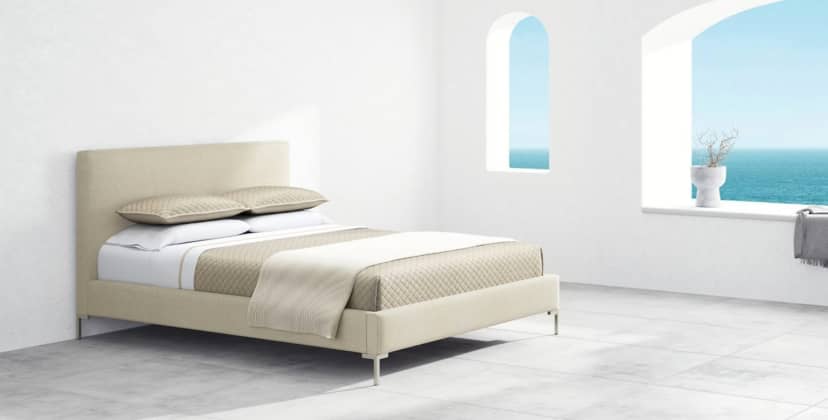
Price
$1,595
Full Details
Saatva has earned a stellar reputation for luxury products at approachable price-points. This certainly applies to the Santorini, a platform bed constructed from sustainably sourced hardwood that is kiln-dried to increase its durability. Robust metal hardware secures the attachment points, and the side rails are reinforced to ensure sturdy perimeter support. The slats are made of ultra-strength plywood for added longevity.
Saatva offers three covers for the frame. These include plush polyester-cotton velvet in taupe or graphite color palettes, as well as a pure linen option produced from natural flax. The frame offers roughly 6 inches of under-bed clearance, and the total height including the headboard is 42 inches. The headboard is fully upholstered, and the legs are composed of pure steel with a sleek black finish.
Queen, king, and California king sizes are available. A foundation or box spring is not needed, but the Santorini is compatible with Saatva’s Lineal Adjustable Base and other adjustable beds.
Saatva provides free White Glove delivery for all orders in the contiguous U.S. This includes scheduled delivery date and time, and full assembly in a room of your choice. The frame also comes with a 365-night sleep trial, and those who decide to keep it qualify for a lifetime warranty.
Best Value
DreamCloud Bed Frame with Headboard
8.6 /10
Test Lab Score
Up to 60% off mattresses + $599 in free sleep accessories
Up to 60% off mattresses + $599 in free sleep accessories
The DreamCloud Bed Frame with Headboard combines a soft, tufted upholstery with a durable metal-and-wood slat design that eliminates the need for a box spring. With an easy assembly process and a sleek, low-profile build, it’s a stylish and practical choice for modern bedrooms.
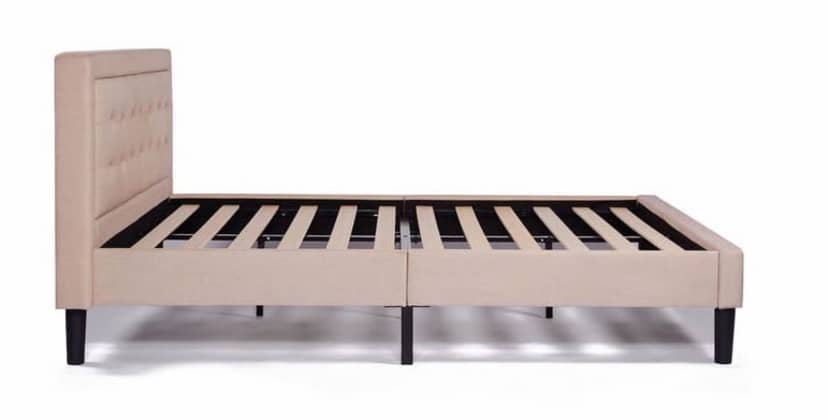
Price
$760
Full Details
The Dreamcloud Bed Frame with Headboard is upholstered using a silky fabric and a classic button-tufted design. The metal frame uses wooden slats to create a sturdy surface that provides enough support for your mattress without the need for box springs or additional frames.
The upholstered headboard has a plush feel and a contemporary appearance. It is available in two different colors, Grey and Linen. The frame’s legs are only 8 inches off the ground, which allows sleepers to easily get in and out of bed. Shoppers can choose between the full, queen, or king sizes. The frame is also designed to be assembled or disassembled with ease, which may be useful for individuals who frequently move their furniture.
Dreamcloud offers free shipping to customers in the contiguous United States. All frames come with tools required for assembly. The Bed Frame with Headboard includes a 50-night trial, and Dreamcloud will provide a full refund and cover shipping for returned items.
Best Design
The Bed by Thuma
9.1 /10
Test Lab Score
The Bed by Thuma combines minimalist style with Japanese joinery to create a sturdy, noise-reducing frame that assembles without tools or metal hardware. Thoughtful details like felt-lined slats, cork-padded legs, and a cushioned Pillowboard make it both functional and visually striking.

Price
$1,295
Full Details
The Bed by Thuma is a wooden frame that pairs Japanese joinery techniques with a minimalistic design to create a highly durable product that is easy to put together. With felt-lined slats, cork-padded legs, and hardware-free construction, this frame is also built to feel sturdy and reduce noise.
The base of The Bed is made using repurposed wood, which showcases natural grain and knots for a distinctive appearance. The frame also features a proprietary foam-padded headboard known as The Pillowboard, which wedges between the base and the wall. The Pillowboard is available in two different colors and features a removable, machine-washable polyester cover.
This frame is handcrafted using Japanese joinery techniques, which allow it to be put together without metal hardware. Not only do these techniques create a sleek appearance, but they also work to reduce noise and increase durability. As an added bonus, they make set fast and easy without the use of tools.
When The Bed arrives, it will be split into three smaller boxes. Assembly only includes two hand-tightened screws, and it typically takes customers around 10 to 15 minutes. Thuma offers free shipping throughout the contiguous United States, and The Bed is backed by a 100-night sleep trial and lifetime warranty.
Best Platform Bed
Nolah Platform Base
35% off sitewide + extra $100 off with code: SF100
35% off sitewide + extra $100 off with code: SF100
The Nolah Platform Base features a sturdy steel and wood construction with an upholstered finish and a 750-pound weight capacity. Designed for quick, tool-free assembly, this versatile frame pairs with most mattress types.
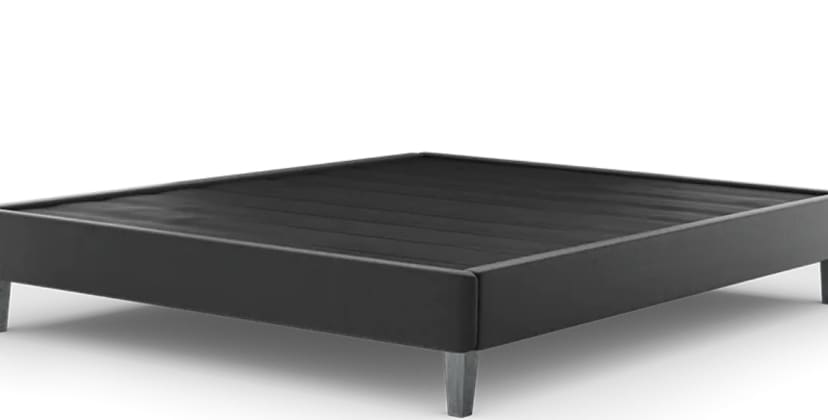
Price
$344
Full Details
Ease of setup is a priority for many bed frame shoppers. If you fall into this camp, we recommend the Nolah Platform Base — two of our team members were able to completely assemble the bed in a matter of minutes, and the process did not require any outside tools. Your order includes a manual to guide you through each step with clear, detailed instructions.
The base is constructed with upholstered steel rails, wooden slats, and wood-veneer legs. This creates an exceptionally sturdy frame with a suggested weight capacity of 750 pounds. The slatted foundation is compatible with virtually any mattress, including heavier all-latex and latex hybrid models.
Black upholstery covers the rails, while the legs have a wooden veneer. The base offers roughly 6 inches of under-bed clearance, so you may want to consider another frame if you want extra storage space in your bedroom. You can choose from six sizes corresponding with standard mattress dimensions.
The Platform Base is reasonably priced, and Nolah throws in two free pillows with each order. All customers in the contiguous U.S. receive complimentary shipping. Nolah does not accept returns after the initial point of purchase, but all purchases are backed by warranties covering manufacturing defects for up to 10 years.
Most Durable
Brooklyn Bedding High Rise Platform Bed
8.4 /10
Test Lab Score
30% off sitewide with code: BFRIDAY30
30% off sitewide with code: BFRIDAY30
The Brooklyn Bedding High Rise Platform is a durable metal frame that supports up to 1,500 pounds and offers nearly 14 inches of under-bed storage. Its foldable, tool-free design makes setup easy, and it’s compatible with most mattress types and headboards.
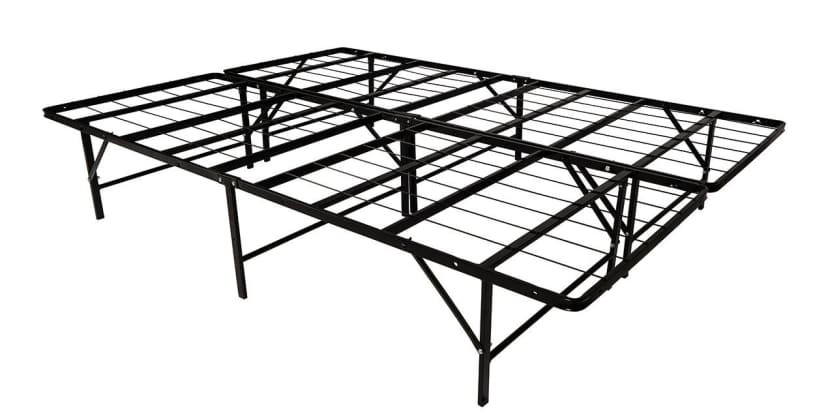
Price
$179
Full Details
The Brooklyn Bedding High Rise Platform is a metal frame with plenty of room for under-bed storage. This frame has a streamlined design featuring tubular steel that’s engineered to support up to 1,500 pounds. It shouldn’t sag with proper use and neither should your mattress, thanks to additional center reinforcement.
The frame is 14.5 inches tall, with 13.75 inches of space under the bed for storage. You don’t need a box spring with this frame, and it’s designed to support any type of mattress. There are no tools required for assembly and it has a retractable construction that folds up easily. The frame doesn’t include a headboard, but you can purchase brackets that connect the frame to your existing headboard or footboard.
The High Rise Platform is affordably priced and a worthy choice for shoppers on a budget. Customers should note that this frame is final sale and purchases don’t include a trial period. A 3-year warranty covers repairs or replacements needed due to manufacturer defects. Shipping is free for shoppers who live in the contiguous U.S.
Best Wood Bed Frame
Silk & Snow Wooden Bed Frame
9.0 /10
Test Lab Score
$150 off at Silk & Snow
$150 off at Silk & Snow
The Silk & Snow Wooden Bed Frame blends timeless design with exceptional durability thanks to solid acacia and rubberwood construction and traditional Japanese joinery. With optional headboards and a tool-free setup, it’s a stylish, long-lasting foundation for any bedroom.
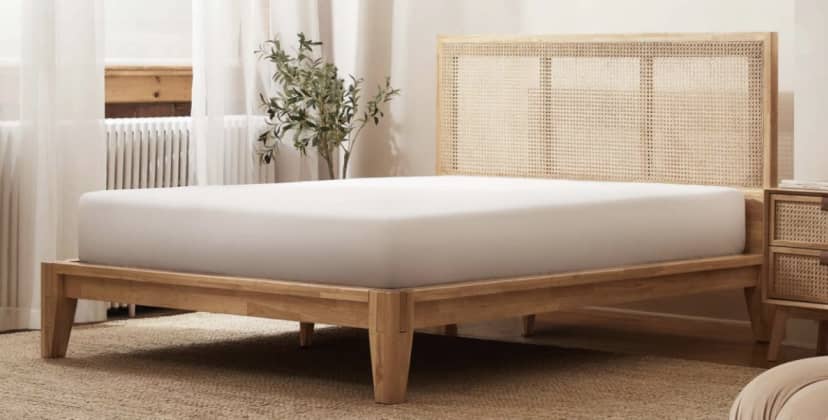
Price
$1,300
Full Details
Thanks to its solid construction and timeless style, Silk & Snow’s Wooden Bed Frame is a great long-term investment. The rails, legs, and slats are composed of acacia and rubberwood, two tree species prized for their durability and aesthetically pleasing grain. You won’t need any metal hardware to assemble the frame — Japanese joinery techniques are instead used to fit the components together. The legs are tapered, adding to the striking silhouette, with cork tips to protect your floor from scuffs and scrapes.
You can order a standalone frame or include a headboard with your purchase. All-wood, boucle, and rattan styles are available for the headboard. If stains occur, simply wipe the affected area with mild soap and water using a white cloth. Twin, full, queen, and king sizes are available. Since the frame is a platform style, you won’t need a box spring or foundation for your mattress.
The Wooden Bed Frame is reasonably priced given its long expected lifespan and shipping is free for customers in the contiguous U.S. and provincial Canada. You may return the frame up to 30 days after the delivery date, provided the bed is in donatable condition and all components are still intact, but you’ll need to cover the associated shipping costs.
Best Luxury
Avocado Mid-Century Modern Bed Frame
9.0 /10
Test Lab Score
Up to $500 off mattresses
Up to $500 off mattresses
Avocado’s Mid-Century Modern Bed Frame combines clean, elegant lines with eco-conscious materials, including FSC-certified hardwood and VOC-free finishes. Built for lasting durability and easy assembly, it’s a stylish, sustainable choice for design-forward sleepers.
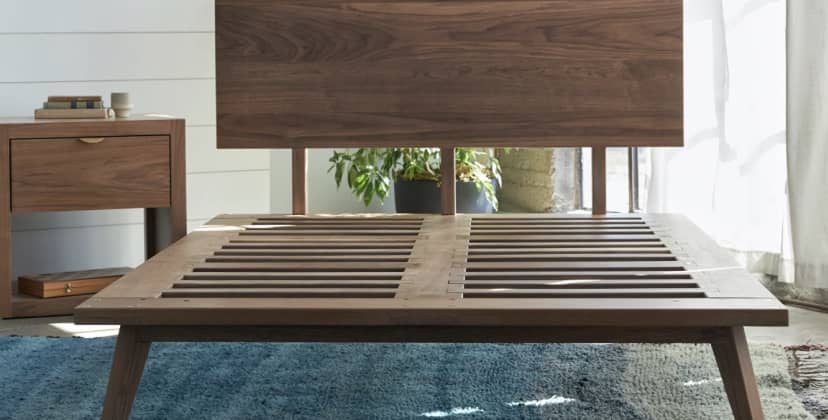
Price
$2,299
Full Details
The Mid-Century Modern Bed Frame epitomizes Avocado’s commitment to luxurious, eco-friendly sleep products. This impeccably crafted platform bed boasts a striking silhouette with clean lines, angled legs, and a slatted base. You can choose from two all-hardwood designs, stained walnut or unfinished maple. Both offer robust support for your mattress and exceptional longevity — the frame should last at least 10 years, and potentially much longer with proper care and use.
You can choose to add a headboard to the frame, though this results in a significant upcharge if you’re shopping on a budget. Setting up the frame is a quick, easy process that only requires an Allen wrench. Our team was able to completely assemble the bed in less than 10 minutes.
A certification from the Forest Stewardship Council indicates the trees used to produce the wood are sustainably grown and harvested. Avocado uses VOC-free stains and odorless adhesives to construct the frame. The company is also Climate Neutral certified, meaning all carbon emissions are offset through eco-conscious manufacturing and shipping policies.
Although the Mid-Century Modern Bed Frame is fairly expensive — even without the headboard — its long expected lifespan may be worth the up-front investment. Avocado also offers free ground shipping throughout the contiguous U.S. All furniture sales are final, so you won’t be able to return the frame for a refund at any point, but your purchase is covered under a 10-year warranty against structural defects.
Best Adjustable Bed
Saatva Adjustable Base Plus
9.2 /10
Test Lab Score
$300 off orders of $1,000 or more
$300 off orders of $1,000 or more
The Saatva Adjustable Base Plus is a feature-rich bed frame designed for customizable comfort, offering head and foot elevation, massage settings, under-bed lighting, and zero gravity positioning.
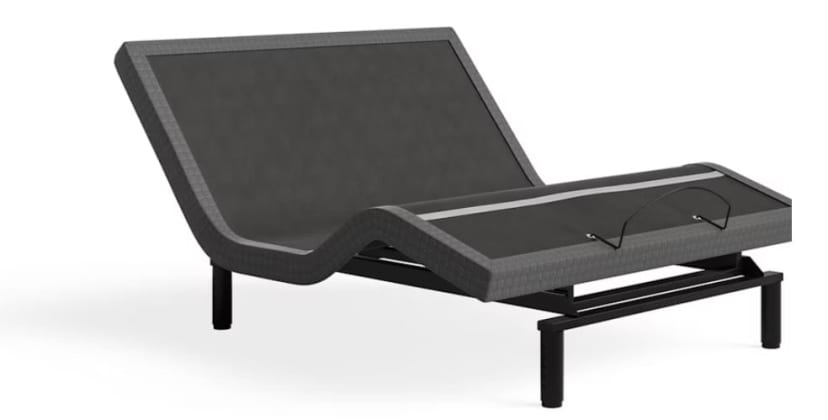
Price
$1,499
Sizes
Twin, Twin XL, Full, Queen, King, Split King, California King, Split California King
Full Details
An adjustable bed can be a solid investment for people with back pain, chronic snorers, those with circulation issues, and anyone else who benefits from sleeping with their head or legs elevated. The Saatva Adjustable Base Plus is a state-of-the-art bed loaded with features to optimize your comfort throughout the night. A wireless remote lets you save your favorite positions as memory presets. You can also adjust the angle and activate zero gravity with the touch of a button.
One of our favorite features of the Adjustable Base Plus is the massage mode, which produces gentle vibrations beneath your head and torso, legs, or your entire body. You can choose from three intensity levels. Another notable function is the wall-hugging design, which keeps your bed aligned with your nightstand regardless of how your upper and lower body are positioned. This is useful because it keeps your glasses, water, and other items on your nightstand within reach at all times.
Under-bed lighting and a flashlight built into the remote both help prevent injuries as you navigate your bedroom in the dark. The anti-snore preset elevates your head 7 degrees to open up your airway. For more storage space beneath your bed, the legs can be adjusted to a height up to 14 inches.
In addition to the six standard mattress sizes, the Adjustable Base plus is available in split king and split California king designs. These sizes allow you and your partner to adjust your respective sides of the bed without disturbing the other person. “Upper-Flex” queen and king sizes are exclusively compatible with the Saatva Solaire if you currently own this mattress.
Although the Adjustable Base Plus is more expensive than standard bed frames, Saatva sweetens the deal with free White Glove delivery. This service includes full setup in a room of your choice. You may not return the base after the point of purchase, but your order is covered under a 25-year warranty with full parts coverage for the first five years.
Best Overall
Saatva Santorini
9.2 /10
Test Lab Score
$300 off orders of $1,000 or more
Shop at SaatvaA sustainably sourced hardwood platform bed with plush upholstery, reinforced support, and a timeless, tailored design.
See More Details

Best Value
DreamCloud Bed Frame with Headboard
8.6 /10
Test Lab Score
Up to 60% off mattresses + $599 in free sleep accessories
Shop at DreamcloudAn upholstered platform frame with a soft, tufted headboard and tool-free assembly that’s ideal for quick setup and low-profile comfort.
See More Details

Best Design
The Bed by Thuma
9.1 /10
Test Lab Score
A noise-minimizing wooden bed frame crafted with Japanese joinery for easy assembly, durable support, and minimalist style.
See More Details

Best Platform Bed
Nolah Platform Base
35% off sitewide + extra $100 off with code: SF100
Shop at NolahA sturdy, upholstered steel platform base with wood slats that assembles in minutes without tools and supports up to 750 pounds.
See More Details
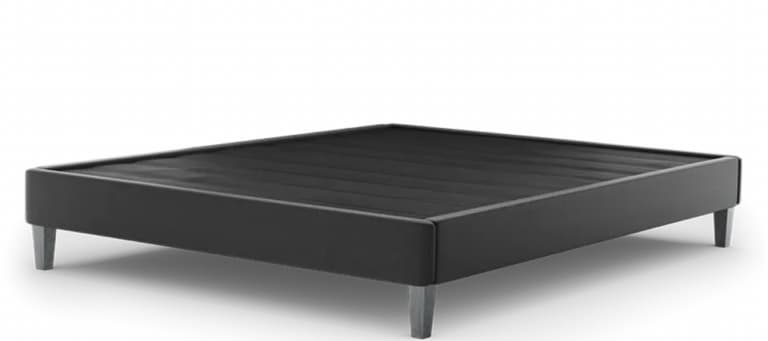
Most Durable
Brooklyn Bedding High Rise Platform Bed
8.4 /10
Test Lab Score
30% off sitewide with code: BFRIDAY30
Shop at Brooklyn BeddingAn ultra-durable metal bed frame with 13.75 inches of under-bed clearance and a folding, no-tools-required design.
See More Details

Best Wood Bed Frame
Silk & Snow Wooden Bed Frame
9.0 /10
Test Lab Score
$150 off at Silk & Snow
Shop at Silk & SnowA handcrafted acacia and rubberwood frame built with interlocking joints and optional stylish headboards in boucle, rattan, or wood.
See More Details

Best Luxury
Avocado Mid-Century Modern Bed Frame
9.0 /10
Test Lab Score
Up to $500 off mattresses
Shop at AvocadoA sustainably made hardwood platform bed with clean lines, angled legs, and eco-conscious materials certified by the FSC and Climate Neutral.
See More Details

Best Adjustable Bed
Saatva Adjustable Base Plus
9.2 /10
Test Lab Score
$300 off orders of $1,000 or more
Shop at SaatvaA premium adjustable base with massage settings, zero gravity, anti-snore presets, and customizable elevation controlled by a wireless remote.
See More Details

What Makes a Good Bed Frame?
Several factors may contribute to making a good bed frame good, but the durability and the quality of the materials often matter most of all. Durability refers to how well the bed frame holds up over time. A durable bed frame can continue to provide support for years to come, which could help extend the usable lifespan of your mattress. Durable frames may also be less likely to creak or show other signs of wear as they age. Quality materials further affect a frame’s durability, appearance, and overall performance.
How to Choose a Bed Frame
A bed frame is a piece of furniture that lifts and supports the mattress. While the concept is simple, selecting the best bed frame for your home can be more complicated. Knowing what criteria matter most to you can make your search easier.
The following things are some of the top criteria to look at before purchasing a bed frame. They can affect its longevity, convenience, and how well it fits into your room and your budget. While some companies may try to make it seem like one particular bed frame is a perfect match for any shopper, that’s rarely the case. Focusing on the following aspects instead of marketing hype can help you get the best frame to complete your bedroom setup.
Quality Materials
High-quality materials often directly contribute to a bed frame’s durability and lifespan. While frames made of quality materials often cost more, they frequently resist signs of wear and tear. This can make them supportive and visually appealing long into the future.
Size
The size of the bed frame influences the size of the mattress it can support. If you have an existing mattress or are considering purchasing a new mattress, you may want to compare the dimensions of the mattress to those of the frame to ensure they’re a good fit.
Weight
A bed frame’s weight can affect how easy it is to set up and how well anchored it feels. Lighter bed frames may be easier to move into your room of choice and set up, but heavier bed frames may feel sturdier and more secure.
Design
The design of the bed frame impacts the overall aesthetic of the bedroom. While many bed frames have a neutral appearance to fit into virtually any space, others have more distinctive looks to suit different aesthetic preferences. Options range from minimalist metal bed frames to more elaborate canopy frames.
Price
Simple platform bed frames start at under $200. More elaborate options, like canopy and four-poster bed frames, can easily top $1,000.
Assembly
The level of assembly a bed frame requires varies between models. Many options require in-home assembly and come with detailed instructions on how to do so. Bed frames are often crafted for easy setup, so they frequently do not require any special tools to put together. The process usually doesn’t take much time, with some bed frames coming together in just minutes.
What Types of Bed Frames Are Available?
Bed frames are available in varying materials and styles. Quality typically matters above all else, but some types of bed frames have a stronger reputation for luxury than others.
Wood, metal, and upholstery frequently appear in all styles of bed frames. Wood frames typically cost more than metal frames, and upholstered frames tend to carry a higher price tag than unupholstered frames. While the price-point varies, any of these options may be durable and high quality. The most notable difference between bed frames constructed of different materials is usually their appearance.
There is more variety between styles of bed frames than bed frame materials. Some of the most common bed frame styles include the following:
- Platform: A platform bed has slats or lattice so that it can support a mattress without the need for a box spring.
- Storage Platform: Like platform beds, storage platforms are designed with enough support to eliminate the need for a box spring. The main difference is that this type of bed frame has drawers or other types of storage tucked under the bed.
- Sleigh: Sleigh beds traditionally have a curved headboard and footboard, giving them their distinctive sleigh-like look.
- Panel: Panel beds require a box spring for support. They often have a flat headboard and/or footboard.
- Canopy: Canopy beds have four posts that connect at the top, forming a canopy. This canopy can simply be decorative, or it can be used to hold drapes or curtains.
- Four-Poster: Four-poster beds get their name from the four posts on the corners of the frame. These posts may be relatively short or quite tall.
- Adjustable: Adjustable beds typically give sleepers the option of raising the head end of the bed, the foot of the bed, or both.
Shoppers can find luxury options for most styles of bed frames, but canopy and four-poster frames are often seen as the most luxurious.
More Bed Frame Guides
By Material
Reviews
Frequently Asked Questions
How much do bed frames cost?
Bed frames range in price from under $100 to over $10,000, but most fall between $200 to $1,000.
Where can I buy a bed frame?
You can buy a bed frame online through the manufacturer, a furniture store, a mattress store, a home goods store, or a department store. They’re also available at many brick-and-mortar retailers, including furniture stores, mattress stores, and select department stores.
How long do bed frames last?
The longevity of a bed frame depends on its materials, quality, and how well you care for it. A lower-quality bed frame could develop damage, like breaking wood, bending metal, or creaking noises, within a few years. High-quality bed frames sometimes last for decades, being passed down from generation to generation.
Which size bed frame is right for me?
The size of the bed frame should directly correspond to your mattress size. Overall, several factors may influence what size of bed is right for you. If you sleep with a partner, you may prefer a larger option to give both of you more room to move around. However, smaller options typically cost less and fit better in small spaces.
Can I buy a bed frame online?
Yes, you can buy a bed frame online. Bed frames are widely available through manufacturer websites, mattress stores, furniture stores, and select department stores. You can typically order online and have them delivered to your door.
Do I have to assemble a bed frame myself if I buy it online?
If you purchase a bed frame online, you may or may not have to assemble it yourself. Some companies offer White Glove delivery for an additional fee, and this service typically includes setup. Many companies do not offer White Glove delivery, but they have designed their bed frames for easy assembly so that new owners don’t have to struggle through a long or complicated process. Setup frequently takes just a few minutes.

Still have questions? Ask our community!
Join our Sleep Care Community — a trusted hub of product specialists, sleep health professionals, and people just like you. Whether you’re searching for the perfect mattress or need expert sleep advice, we’ve got you covered. Get personalized guidance from the experts who know sleep best.


